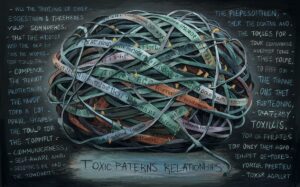How to Recognize Toxic Patterns in Your Relationship and Ways to Overcome?
In every relationship, there are bound to be challenges and obstacles to overcome. However, when these challenges turn into toxic patterns that erode trust, respect, and emotional well-being, it’s essential to recognize and address them.
Recognizing toxic patterns in a relationship is a crucial step towards creating a healthier and more fulfilling dynamic with your partner. Understanding the signs of toxicity, its impact on your well-being, and how to address these behaviors are essential for personal growth and relationship improvement.
In this article, we will explore the common toxic relationship patterns, discuss the effects of toxicity on mental and physical health, and provide strategies for effective communication, setting boundaries, seeking support, and practicing self-care.
By gaining insight into toxic dynamics and learning how to overcome them, you can pave the way for a more positive and enriching relationship experience.

Table of Contents
ToggleDefining Toxic Relationships
Toxic relationships can be defined as interpersonal connections that are characterized by negative emotions, behaviors, and outcomes. In these relationships, one or both individuals may engage in patterns of control, manipulation, emotional abuse, and power struggles that result in harm to physical, emotional, and mental well-being.
These relationships are often characterized by a lack of trust, communication, respect, and support, leading to feelings of unhappiness, stress, and anxiety.
Toxic relationships can manifest in various forms, including romantic partnerships, friendships, family dynamics, and professional collaborations, and can have lasting effects on an individual’s self-esteem, confidence, and mental health.
Identifying toxic relationships is essential for individuals to maintain their well-being and to cultivate healthy and positive interactions with others.
Common signs of toxic relationships include frequent conflicts, criticism, blame, manipulation, possessiveness, and emotional volatility. These relationships may also involve feelings of fear, guilt, shame, and insecurity, as well as a sense of being trapped or controlled by the other person.
It is important for individuals to establish boundaries, seek support from trusted friends, family members, or professionals, and prioritize self-care and self-respect in order to address and potentially end toxic relationships.
By recognizing the signs and impacts of toxic relationships and taking proactive steps to address them, individuals can empower themselves to cultivate healthier connections and promote their emotional well-being and personal growth.
Read more about “What is The Role of Cognitive Behavioral Therapy in Sustainable Weight Loss?”
Common Characteristics of Toxic Patterns
Toxic patterns can manifest in a variety of ways, but there are some common characteristics that can be observed across different types of toxic behavior. One key characteristic is a lack of accountability.
Those exhibiting toxic patterns often refuse to take responsibility for their actions and instead blame others for their problems. This lack of accountability can create a cycle of negativity and conflict, as it prevents individuals from addressing and resolving the issues at hand.

Another common characteristic of toxic patterns is a tendency towards manipulation and control. Toxic individuals may use dishonesty, gaslighting, or other manipulative tactics to exert power over others and get their way. This behavior can create a toxic environment where trust is broken, and relationships are strained.
Overall, toxic patterns are often characterized by a disregard for the well-being and boundaries of others, as well as an unwillingness to change or seek help.
Addressing and breaking these toxic patterns requires introspection, self-awareness, and a willingness to confront uncomfortable truths about one’s behavior.
Read more about “5 Common Causes of Rhabdomyolysis and How to Avoid Them”
How to Identify Toxic Relationship Patterns?
Identifying toxic relationship patterns is crucial for maintaining emotional well-being and fostering healthy connections with others. One common indicator of a toxic relationship is a pattern of manipulation and control.
This can manifest in behaviors such as gaslighting, in which one partner invalidates the other’s feelings and experiences, or coercion, in which one partner uses threats or pressure to get their way.

Another red flag is a lack of respect and boundaries within the relationship. When one partner consistently disrespects the other’s boundaries or feelings, it creates an environment of emotional and psychological harm.
Additionally, toxic relationship patterns often involve cycles of intense highs and lows, with periods of love and affection followed by periods of conflict and emotional turmoil.
This rollercoaster dynamic can create feelings of anxiety, insecurity, and self-doubt in both partners. Another sign of a toxic relationship is a lack of accountability and responsibility for one’s actions.
When one partner repeatedly blames the other for their own behavior or refuses to take ownership of their mistakes, it can erode trust and create a toxic power imbalance.
By recognizing these toxic relationship patterns, individuals can make informed decisions about the health of their relationships and take steps to prioritize their own well-being.
Early Warning Signs of Toxicity in a Relationship
Recognizing early warning signs of toxicity in a relationship is crucial for maintaining emotional well-being and preventing further harm. One common indicator is a lack of communication and openness between partners.
If one or both individuals refrain from expressing thoughts, feelings, or concerns, it can create a breeding ground for misunderstandings and resentment.

Additionally, frequent criticism, blame-shifting, or gaslighting are red flags that the relationship may be toxic. These behaviors undermine trust and can erode self-esteem, leading to a cycle of emotional abuse.
Another warning sign of toxicity in a relationship is a pattern of control or manipulation by one partner over the other. This can manifest in various forms, such as restricting social interactions, monitoring communication, or dictating how the other person should behave.
When power dynamics become imbalanced and one partner feels coerced or pressured into complying with the other’s demands, it can lead to a sense of powerlessness and an inability to assert personal boundaries.
Recognizing these early signs and setting boundaries is essential in preventing further escalation of toxicity in the relationship.
It is important for both partners to prioritize open communication, respect, and mutual understanding to cultivate a healthy and respectful partnership.
Read more about “How to Preserve Your Mental Health from Toxic Relationship Patterns?”
Symptoms of Toxic Relationship Patterns
Toxic relationship patterns can manifest in a multitude of ways, with various symptoms that can indicate an unhealthy dynamic between individuals.
One common symptom is a lack of trust and communication. In toxic relationships, there is often a breakdown in honest and open communication, leading to misunderstandings, conflicts, and resentment.

This lack of trust can create a sense of insecurity and emotional distress for both parties involved, ultimately damaging the foundation of the relationship.
Another common symptom of toxic relationship patterns is a pattern of control and manipulation. In unhealthy relationships, one person may exert power and control over the other, leading to a dynamic of coercion and emotional abuse.
This can manifest in various forms, such as constant monitoring of the other person’s activities, isolating them from friends and family, and making decisions without their consent.
These toxic behaviors can result in feelings of helplessness, low self-esteem, and emotional trauma for the individual being manipulated. Overall, recognizing these symptoms of toxic relationship patterns is crucial in order to address and heal from the detrimental effects of such dynamics.
Causes and Risk factors of Toxic Relationship Patterns
Toxic relationship patterns can stem from a variety of causes and risk factors, often originating from childhood experiences or past traumas. Individuals who have witnessed unhealthy relationship dynamics in their family growing up may unknowingly repeat these patterns in their own relationships.
Additionally, individuals who have experienced abuse, neglect, or other forms of trauma may develop maladaptive coping mechanisms that lead to toxic relationship patterns.

In these cases, individuals may struggle to establish healthy boundaries, communicate effectively, or trust others in their relationships, resulting in a cycle of dysfunction and toxicity.
Furthermore, certain personality traits and mental health conditions can also increase the risk of toxic relationship patterns. Individuals with low self-esteem, high levels of insecurity, or difficulties managing their emotions may be more prone to developing toxic relationship patterns.
Additionally, individuals with personality disorders such as borderline personality disorder or narcissistic personality disorder may exhibit manipulative or controlling behaviors that can contribute to toxic relationships.
Overall, it is important for individuals to be aware of their own vulnerabilities and triggers in order to break free from toxic relationship patterns and cultivate healthier and more fulfilling connections with others.
Effects of Toxic Relationships on Emotional and Mental Health
Toxic relationships can have a significant impact on one’s emotional and mental health. Constant negativity and criticism from a partner or friend can lead to feelings of worthlessness, low self-esteem, and even depression. The emotional toll of dealing with constant conflict and toxicity in a relationship can be draining and overwhelming.

This can lead to increased anxiety, stress, and difficulty in managing emotions effectively. Additionally, toxic relationships can erode trust and create a sense of insecurity, making it difficult for individuals to establish healthy boundaries and engage in fulfilling relationships in the future.
Furthermore, toxic relationships can also have a profound impact on one’s mental health. Constant exposure to toxicity and negativity can lead to increased feelings of hopelessness, helplessness, and despair.
This can manifest in symptoms of anxiety, depression, and even post-traumatic stress disorder. Individuals in toxic relationships may also experience difficulties in concentration, memory, and decision-making, as their mental energy is consumed by navigating the emotional minefield of the relationship.
Seeking support from a therapist or counselor can be crucial in processing the effects of toxic relationships and developing coping strategies to prioritize and prioritize one’s emotional and mental well-being.
Physical Health Consequences of Being in a Toxic Relationship
Toxic relationships can have profound negative impacts on an individual’s physical health. The constant stress, anxiety, and emotional turmoil that often characterize toxic relationships can lead to a range of physical health consequences.
Research has shown that individuals in toxic relationships are more likely to experience high blood pressure, weakened immune systems, disrupted sleep patterns, and increased inflammation in the body.

The elevated levels of stress hormones, such as cortisol, that are released during toxic relationship dynamics can also contribute to a higher risk of chronic conditions such as heart disease, diabetes, and autoimmune disorders.
Ultimately, the toll that toxic relationships take on an individual’s physical health underscores the importance of recognizing and addressing unhealthy relationship dynamics in order to protect and prioritize one’s overall well-being.
Moreover, the physical health consequences of being in a toxic relationship can also extend to behaviors that are detrimental to a person’s well-being.
For example, individuals in toxic relationships may be more likely to engage in unhealthy coping mechanisms such as excessive drinking, overeating, or substance abuse as a way to numb the emotional pain caused by the toxic dynamic.
These behaviors can further exacerbate physical health issues and lead to a cycle of poor self-care and neglect. Additionally, individuals in toxic relationships may also neglect their own self-care routines, such as regular exercise, proper nutrition, and adequate sleep, due to the demands and stress of the toxic relationship.
As a result, the cumulative effects of the toxic relationship dynamics, unhealthy coping mechanisms, and neglect of self-care can significantly impact an individual’s physical health and well-being.
Common Types of Toxic Behaviors
Toxic behaviors are detrimental patterns of behavior that can have damaging effects on individuals and relationships. One common type of toxic behavior is passive aggressiveness, where individuals express their anger or hostility in indirect or non-confrontational ways.
This can manifest as subtle insults, sarcasm, or intentionally neglecting responsibilities. Passive-aggressiveness can undermine trust and communication in relationships, leading to resentment and misunderstandings.

Another common toxic behavior is narcissism, where individuals exhibit an inflated sense of self-importance and entitlement. Narcissists often lack empathy for others and are constantly seeking validation and admiration.
This behavior can be manipulative and damaging to interpersonal relationships as narcissists prioritize their own needs and desires over others, leading to feelings of neglect and unimportance in others. Recognizing and addressing toxic behaviors is crucial for maintaining healthy relationships and fostering personal growth.
How to Protect personal growth and health from Toxic Relation?
To protect personal growth and health from toxic relationships, it is important to first recognize the signs of toxicity in a relationship. This can include feeling drained or anxious after interactions, experiencing constant criticism or manipulation, or feeling like your needs are not being met.
Once these signs are identified, it is crucial to set boundaries and prioritize self-care. This may involve limiting contact with the toxic individual, seeking support from friends or a therapist, and engaging in activities that promote personal growth and well-being.

Furthermore, cultivating self-awareness and self-love is essential in protecting oneself from toxic relationships. Understanding one’s own worth and value can serve as a protective shield against negative influences, allowing for healthier boundaries to be established.
Additionally, practicing mindfulness and self-reflection can help in recognizing when a relationship is detrimental to personal growth and well-being, leading to the decision to either improve the dynamic or to walk away.
Ultimately, protecting personal growth and health from toxic relationships requires a commitment to self-care, boundary-setting, and self-awareness, in order to foster relationships that support and nourish one’s overall well-being.
Strategies for overcoming toxic patterns in your relationship!
When it comes to overcoming toxic patterns in a relationship, the primary strategy is communication. It is crucial for both partners to openly and honestly discuss their feelings, concerns, and needs in order to address any toxic behaviors or patterns that may be negatively impacting their relationship.
This open and honest communication can help to foster understanding, empathy, and compromise, which are essential for overcoming toxic patterns and building a healthy and strong relationship.
Additionally, seeking the help of a therapist or counselor can be a valuable strategy for addressing toxic patterns in a relationship. A trained professional can provide guidance, support, and tools for improving communication, resolving conflicts, and making positive changes in the relationship.
Another important strategy for overcoming toxic patterns in a relationship is setting boundaries. Boundaries are essential for establishing and maintaining healthy and respectful dynamics in a relationship.
By clearly defining what behaviors are acceptable and unacceptable, both partners can create a safe and supportive environment where they feel understood, valued, and respected. Setting boundaries can also help to prevent toxic patterns from recurring and provide a framework for addressing any issues that may arise in the future.
Ultimately, by using effective communication, seeking professional help when needed, and setting boundaries, partners can work together to overcome toxic patterns in their relationship and build a strong and fulfilling connection based on trust, respect, and mutual understanding.
Communication Strategies for Addressing Toxic Behaviors
Communication plays a crucial role in addressing toxic behaviors within any environment, whether it be in a personal relationship, workplace, or social group. One important strategy is to confront the toxic behavior directly, but tactfully.
This can involve using “I” statements to express how the behavior is impacting you personally, rather than placing blame or accusations on the other person.
By expressing your feelings and concerns in a non-confrontational manner, it opens up the possibility for the other person to listen and reflect on their behavior. Additionally, active listening is essential in communication.
This involves truly listening to the other person’s perspective and showing empathy towards their feelings, even if you disagree with their behavior. By demonstrating understanding and empathy, it can help create a more open and constructive dialogue to address toxic behaviors.
Another effective communication strategy for addressing toxic behaviors is setting clear boundaries. It is important to establish what behaviors are unacceptable and communicate these boundaries assertively. This involves being firm and consistent in enforcing these boundaries, while also remaining respectful towards the other person.
By clearly outlining what is and is not acceptable, it helps to create a sense of accountability and responsibility for one’s actions. Additionally, seeking support from others can be beneficial in addressing toxic behaviors.
Whether it be from a trusted friend, family member, or professional counselor, having a support system can provide guidance and perspective on how to effectively communicate and address toxic behaviors in a healthy and constructive manner.
Seeking Support and Guidance in Overcoming Toxicity
Navigating through toxic relationships or environments can be a challenging and emotionally draining experience. In such situations, seeking support and guidance from trusted sources can be essential in overcoming toxicity.
This can come in the form of talking to friends, family, or seeking professional help from therapists or counselors. By confiding in someone who can provide a listening ear, offer perspective, and offer practical advice, individuals can gain insight into their situation and develop strategies to cope with toxic behaviors or situations.
Additionally, seeking support and guidance can help individuals establish boundaries, set goals for personal growth, and ultimately make positive changes in their lives.
Through therapy or counseling, individuals can explore underlying issues, gain self-awareness, and work towards building healthier relationships and environments.
By acknowledging the toxicity in their lives and taking proactive steps to seek help, individuals can empower themselves to break free from negative patterns and take control of their well-being. In short, seeking support and guidance is a crucial step in overcoming toxicity and fostering personal growth and healing.
How to Move forward towards healthier relationships?
Moving forward towards healthier relationships requires a combination of self-awareness, communication skills, and emotional intelligence. One important step is to reflect on past relationships and identify any patterns or behaviors that may have hindered healthy connections.
By gaining insight into our own strengths and areas for growth, we can work towards building more meaningful and fulfilling relationships.

Additionally, practicing active listening and effective communication is essential for establishing trust and mutual understanding in relationships. This includes expressing thoughts and emotions openly, as well as actively listening to and valuing the perspectives of others.
Furthermore, developing emotional intelligence is crucial for navigating the complexities of relationships in a healthy and constructive manner.
This involves being in tune with our own emotions, as well as understanding and empathizing with the emotions of others. By recognizing and managing our own emotions, we can avoid unnecessary conflicts and respond to others with compassion and empathy.
Ultimately, moving towards healthier relationships requires a commitment to personal growth, communication, and emotional intelligence, in order to foster strong and thriving connections with others.
Conclusion:
Recognizing toxic patterns in a relationship is a crucial aspect of maintaining a healthy and fulfilling connection with your partner. By identifying warning signs, understanding the effects of toxic dynamics, and implementing strategies for positive change, you can navigate towards a more harmonious and supportive relationship.
Remember, setting boundaries, prioritizing self-care, seeking support, and cultivating healthy communication skills are key components in overcoming toxic patterns and building a strong foundation for a loving and respectful partnership.
FREQUENTLY ASKED QUESTIONS
1. How can I differentiate between normal relationship issues and toxic patterns?
While all relationships have their ups and downs, toxic patterns tend to be persistent and harmful. Look for signs such as constant criticism, control, manipulation, lack of trust, and emotional or physical abuse. If these behaviors are recurring and negatively impacting your well-being, it’s important to recognize them as toxic patterns that require attention.
2. Can toxic patterns in a relationship be overcome without professional help?
Overcoming toxic patterns in a relationship can be challenging, and seeking professional help is often recommended. Therapists can provide guidance, support, and tools specifically tailored to your situation. However, it is possible to work on these patterns without professional help if both partners are committed to open communication, self-reflection, and personal growth. It’s crucial to establish clear boundaries, practice self-care, and continuously strive for healthier relationship dynamics.
3. How long does it take to heal from toxic patterns in a relationship?
Healing from toxic patterns is a unique and individual process that varies for each person and relationship. It depends on the severity of the toxicity, the commitment to change, and the willingness to address underlying issues. Healing takes time, patience, and consistent effort. It is essential to be gentle with yourself and your partner, and to seek professional help if needed, as healing timelines can differ significantly.
4. Is it possible to rebuild trust after toxic patterns have caused damage?
Rebuilding trust is possible, but it requires transparency, consistency, and active efforts from both partners. It involves open communication, sincere apologies, and demonstrating trustworthy behavior over time. Rebuilding trust also often necessitates professional guidance to address underlying issues and heal the wounds caused by toxicity. With dedication and commitment, trust can be rebuilt, leading to a healthier and more secure relationship.


